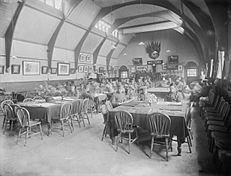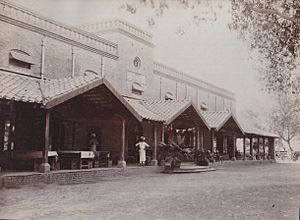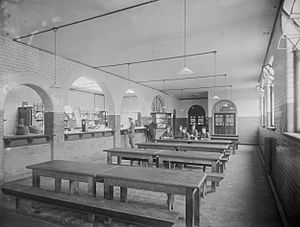Elise Sandes facts for kids
Elise Sandes (born 1861 – died August 1934) started a special support group for soldiers. This group is still active today and is named after her. Elise was a kind person who believed in helping others. She became worried about a young soldier in Tralee in the late 1860s. This led her to create a place where soldiers could relax and get help.
By 1913, there were 31 such 'soldiers' homes'. They were all near army camps. Twenty-two of these homes were in Ireland, and the rest were in British India. People widely believed that Sandes Homes were very well run. They met a real need for young soldiers who were often far from their families. These homes made soldiers feel welcome and comfortable, unlike the usual army canteens. Elise Sandes felt that a caring, motherly influence was very important for young soldiers. For some new recruits, these 'homes' were the only place they found such care.
After 1921, only three Sandes homes stayed open in the Irish Free State. But there were still 20 homes in total in the late 1920s, mostly in India. Elise Sandes was honored for her work helping people and her dedication to soldiers. She is one of only two civilian women to be buried with full military honors. The other woman was Eva Maguire, who took over from Elise.
Contents
Early Life of Elise Sandes
Elizabeth Anne (Elise) Sandes was born in 1851 in Oak Villa, Oakpark, Tralee. Her family was quite well-off. Her parents were Stephen Creagh Sands, an army officer, and Mary Anne Ponsonby. Elise had six sisters and two brothers. She was known as a very smart child who loved to read and learn. She even remembered reading and writing letters before she went to school.
One of her friends from a nearby estate later became the famous British Army officer Earl Kitchener. Elise was very sad when her father died in 1866. She was only fifteen years old. She found comfort with her good friend Mary Fry. Together, the girls decided to help others. At that time, British soldiers were stationed in many parts of Ireland. Mary felt sad to see young soldiers, around eighteen years old, getting into trouble.
Mary started inviting these young soldiers to her home. She encouraged them to talk and ask questions. Elise became interested, and they both worked and prayed for the young soldiers. Sadly, Mary died not long after. But before she passed away, she asked Elise to befriend a young soldier near her home in Tralee.
Starting Sandes Homes for Soldiers
In 1869, Elise invited that young soldier and his friends to her mother's house. They met regularly for Bible study, prayers, and singing. They also had lessons in reading and writing. Soldiers were happy to accept the invitation. By 1871, so many soldiers came that the meetings had to move to a new place in Nelson Street.
Elise first felt especially sorry for the drummer boys. They were only fifteen when they joined the Army. But many older, experienced soldiers also wanted the same friendship and support. Soon after, the soldiers' regiment moved to Cork. Elise met them again and learned how much they missed the friendly atmosphere of the rooms in Tralee. She also saw that many soldiers in Cork were struggling.
Elise decided to find a new place in Cork for them. With help from a kind retired Naval Officer, rooms in King Street were bought for £259. This is where the first 'Sandes Home for Soldiers' opened on June 10, 1877.
Even though the organization officially started in 1869, the Cork building was the first to be called a 'Sandes Home'. Its goal was to offer soldiers a friendly place for companionship, fun, and self-improvement. The house looked like a normal home. But Elise worked hard to make the rooms bright and cozy. She wanted the homes to always feel welcoming. Prayers and religious services were always offered to soldiers who wanted to join.
The ground floor of the first homes usually had a tea room, a meeting room, and a reading room. The top floor had private rooms for the people who ran the home. Soon, many more homes were set up in different, far-off places across the British Empire.
"I try to make my Homes not institutes or clubs or mission halls, but in the truest sense of the word 'HOMES' that any Christian mother would allow for her boys, I feel free to have for my soldiers." Elise Sandes 1877
Many people were eager to help Elise. They dedicated their lives to guiding men towards a better path. Elise Sandes was a strong leader who made a big impression on everyone she met.
Reports from that time show that by September 1887, when Miss Sandes planned a Home in Belfast, there were already Homes in Dublin, The Curragh, and Limerick, as well as the first one in Cork. Miss Sandes attended a meeting in Belfast to start the new project. She talked about how the Cork Home worked and its benefits. She explained that it had "religious and temperance meetings for those who wished to attend." It also had "reading, recreation, smoking, and coffee rooms for social gatherings. The Home was crowded every night."
Sandes Homes in British India
Elise's family had a history of military service and connections with India. Elise knew how uncomfortable, lonely, and boring a soldier's life could be in India. It was often a lot of waiting and strict rules. Anna Ashe set up the first home in Rawalpindi with money from a donor. Theodora Schofield and Alice Bailey followed her lead. They set up more homes in Murree, Quetta, Meerut, and Lucknow.
Elise Sandes then decided to open a Sandes Home in every army camp, called a cantonment, in India. By this time, she was widely known as the Mother of the British Army. This was because of her special dedication to giving young soldiers the care they needed. She created the phrase 'A Home From Home'. This perfectly described the welcoming environment she wanted to provide.
Sandes Homes During World War One
Elise Sandes was at Coolmoney camp in 1914 when World War One began. Army camps quickly grew as thousands of reserve soldiers and new recruits joined. Elise and her helpers soon understood the terrible reality of war. They learned about it from the many letters sent from the trenches. The number of soldiers hurt or killed was shocking. It was clear that some of the men were very young, even below the legal age for fighting.
For over four years, these humanitarians worked to prepare men for the strong chance of death. These men had little idea of the dangers of modern warfare. Along with prayers, they offered practical help. They sent packages to men at the front. These packages had food, clothing, books, magazines, and treats. Women also went onto troopships before they sailed. They handed out postcards and pencils for soldiers to send a last message home.
Elise Sandes' Death
When the Irish Free State was formed, most of the homes in Ireland closed. Elise Sandes left the Curragh on August 3, 1922. She moved to a new home in Ballykinlar, County Down. She died there in August 1934. She was buried in nearby Tyrella with full military honours. Elise Sandes and her successor, Eva Maguire, are the only civilian women to receive this special honor. Both women also received important awards: Elise the CBE and Eva the OBE. Elise Sandes' simple headstone reads: ‘For 66 years the friend of soldiers’.
Closure of Sandes' Homes
All the homes in India closed in 1947. This was when India became independent and the British left. For a short time after World War II, there were homes in places like Borneo, Hong Kong, Jamaica, Malaysia, Singapore, and even Iceland. None of these international centers are still open today.
Three of the homes in Ireland stayed open for much longer. One was in the Curragh, at the request of the Irish Army. Another was in Cobh (Queenstown), and one was in Dublin. The last two closed soon after. But the home in the Curragh stayed open until the 1980s. It survived mainly because the women who ran it were very determined.
1974 Bombing
The Sandes Soldiers Home at Abercorn Barracks, Ballykinler was bombed on October 28, 1974. This was a terrorist attack by the Provisional Irish Republican Army. A large bomb was hidden in a delivery van across the road from the Sandes Home. The building caught fire and was badly damaged very quickly. Two soldiers, Lance Corporal Alan Coughlin and Private Michael Swanick, lost their lives. Thirty-one other soldiers and two civilians were injured in the attack. In 1986, a memorial stone was put up outside a new Sandes Home built on the same spot. It honors the two soldiers who died.
Sandes Today
Today, the organization is called 'Sandes Soldiers' and Airmen's Centres'. They have locations in Thievpal Barracks, Lisburn, Ballykinlar, and Holywood in Northern Ireland. They also have centers in Pirbright and Harrogate in Great Britain. The staff includes eighteen full-time workers.
Since its small beginnings in 1869, Sandes has become a very important part of the military community. It is recognized for its valuable work. Over the years, Sandes has changed to meet the needs of each new generation of servicemen and women.





